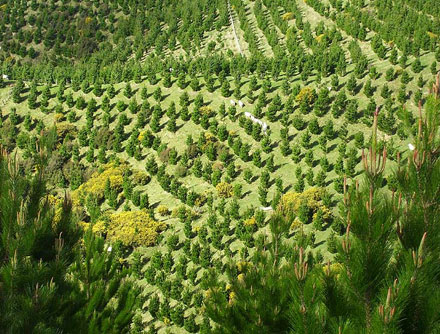
Taranaki’s logging contractors are gearing up to harvest a bumper crop over the next few years as trees planted more than two decades ago begin to mature. Source: Stuff NZ
Many of the plots around Taranaki were planted in the ‘90s, with most taking between 25 and 30 years before they were ready to be cut.
New Zealand Forestry regional manager Cam Eyre said there is around 19,000ha of Radiata pine in the Taranaki region, 80% of which was due to be harvested from 2015 for the next six or seven years.
“It’s all over the place, down close to Whanganui, it will all come through New Plymouth’s port, and then out near Te Kuiti, out on the Forgotten World Highway all that wood from all over the place comes through Port Taranaki which is good,” he said.
Port Taranaki has already seen an increase in logging exports coming through in the last year.
A record volume of 357,000 JAS (Japanese Agricultural Standard tonnage) was exported from the port in the 2015-16 financial year, an increase from the 209,000 JAS of the previous year, which resulted in an 80% increase in revenue for the port from its log business in the 2015-16 financial year.
“Signs are good for that growth to continue,” Port Taranaki chief executive Guy Roper said.
“Our half-year throughput to 31 December is up a third on the same six months last year, and we expect trade could grow by as much as 10 per cent a year across the next four years.”
Eyre organised a breakfast for about 150 forestry staff to remind them to look out for themselves and their work mates as they returned to work after the holiday period.
“It’s a reminder to the boys about the risks that are involved with working in the forests and this is a really hot time for us, a lot of the fatalities that happen in the forest usually happen in those first few days when everyone goes back to work, so it’s a way of getting everyone together and really having a real health and safety focus when you start up,” Mr Eyre said.
Safety breakfasts were not uncommon in the industry around the rest of the country but it was a new thing for Taranaki as they were usually organised by the big corporations that owned the forests.
“Because all the wood in Taranaki is private, you might have had small gatherings but nothing like this so it was really good to see,” he said. “Most of the guys know each other so it’s good to see them chat and see what the other guys are up to as well.”
Taranakipine chief executive Tom Boon said they were expecting a rise in the amount of product coming onto the market in the next few years from the plots planted in the 90s.
“Those trees are maturing now and they’re ready to harvest, it’s kind of happening now and will continue for a long time as forest owners look to harvest those trees,” he said.
While Taranakipine and other sawmills around the region would be buying some of the logs, there would be a lot of it that would be exported to Asia and the rest of the world and there was definitely a market willing to buy it, he said.
“We can’t take them all,” Boon said. “The market is well beyond what Taranaki has got in terms of sawmilling, there’s a massive export market and that’s where a big proportion of those logs will go.”
He said it was important to ensure there was adequate infrastructure available and the manpower in the region to deal with the increase.
“The likes of Cam, they’re trying to get logging crews and trucks and roading and the port’s got to be able to handle them,” he said.





